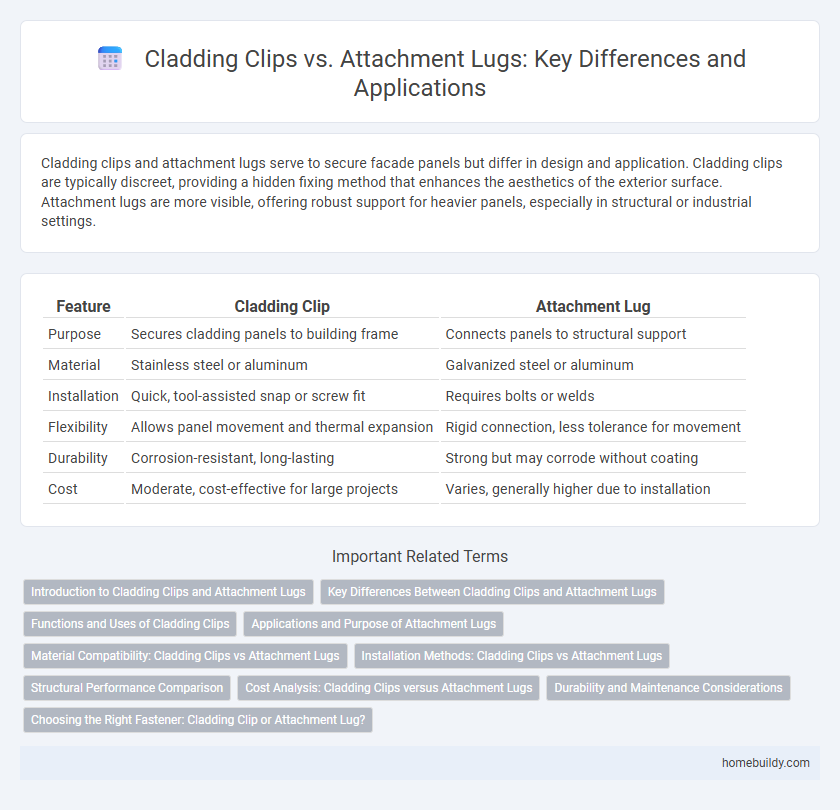Cladding clips and attachment lugs serve to secure facade panels but differ in design and application. Cladding clips are typically discreet, providing a hidden fixing method that enhances the aesthetics of the exterior surface. Attachment lugs are more visible, offering robust support for heavier panels, especially in structural or industrial settings.
Table of Comparison
| Feature | Cladding Clip | Attachment Lug |
|---|---|---|
| Purpose | Secures cladding panels to building frame | Connects panels to structural support |
| Material | Stainless steel or aluminum | Galvanized steel or aluminum |
| Installation | Quick, tool-assisted snap or screw fit | Requires bolts or welds |
| Flexibility | Allows panel movement and thermal expansion | Rigid connection, less tolerance for movement |
| Durability | Corrosion-resistant, long-lasting | Strong but may corrode without coating |
| Cost | Moderate, cost-effective for large projects | Varies, generally higher due to installation |
Introduction to Cladding Clips and Attachment Lugs
Cladding clips serve as advanced fastening solutions designed to securely attach cladding panels to building structures, ensuring durability and weather resistance. Attachment lugs, often simpler in design, provide basic mechanical connections but may lack the flexibility and load distribution capabilities of cladding clips. Choosing cladding clips over attachment lugs enhances structural integrity, facilitates thermal expansion, and improves installation efficiency in facade engineering.
Key Differences Between Cladding Clips and Attachment Lugs
Cladding clips provide secure and adjustable fastening for exterior panels, offering enhanced flexibility in thermal expansion compared to attachment lugs, which are primarily rigid and fixed connectors. The design of cladding clips minimizes structural stress by allowing slight movement, whereas attachment lugs are typically used for straightforward, permanent attachment without movement accommodation. Material compatibility and load distribution also differ, with cladding clips often made from corrosion-resistant alloys tailored for facade systems, while attachment lugs focus on direct load transfer with simpler fabrication.
Functions and Uses of Cladding Clips
Cladding clips serve as essential connectors that securely hold facade panels to building structures, offering flexibility to accommodate thermal expansion and contraction. Unlike attachment lugs, cladding clips provide a concealed fastening solution that enhances the aesthetic appearance by eliminating visible screws or bolts. Their primary function is to ensure the stability and longevity of cladding systems in both commercial and residential applications while allowing for easy installation and maintenance.
Applications and Purpose of Attachment Lugs
Attachment lugs serve a critical role in securing cladding systems by providing robust mechanical connections between panels and structural frameworks, ensuring enhanced stability under wind and seismic loads. Unlike cladding clips that primarily offer friction fit and ease of installation, attachment lugs are engineered for high-load resistance applications such as curtain walls, ventilated facades, and heavy composite panels. Their design supports precise alignment and long-term durability, making them ideal for commercial and industrial building envelopes requiring stringent safety and performance standards.
Material Compatibility: Cladding Clips vs Attachment Lugs
Cladding clips are typically made from stainless steel or aluminum, offering superior corrosion resistance and compatibility with various facade materials such as metal panels, stone, and composite cladding. Attachment lugs, often fabricated from galvanized steel, may face compatibility challenges with some cladding materials due to potential galvanic corrosion risks. Selecting the appropriate material for cladding clips or attachment lugs ensures long-term durability and structural integrity in facade installations.
Installation Methods: Cladding Clips vs Attachment Lugs
Cladding clips enable faster, tool-free installation by snapping into place, reducing labor costs and minimizing structural damage during facade assembly. Attachment lugs require mechanical fastening with screws or bolts, offering a more secure connection suitable for heavier panels but increasing installation time and complexity. The choice between cladding clips and attachment lugs depends on project demands for speed, panel size, and wind load resistance.
Structural Performance Comparison
Cladding clips provide superior structural performance compared to attachment lugs due to their enhanced load distribution and flexibility under dynamic stresses. Their design minimizes thermal bridging and allows for controlled movement of cladding panels, reducing the risk of material fatigue and failure. Attachment lugs, while simpler, often concentrate stress at fastening points, leading to potential structural weaknesses over time.
Cost Analysis: Cladding Clips versus Attachment Lugs
Cladding clips offer a more cost-effective solution compared to attachment lugs due to lower material expenses and simplified installation processes. Attachment lugs often require more labor-intensive fastening methods, increasing overall project costs and time. Evaluating long-term maintenance and durability, cladding clips reduce the total cost of ownership by minimizing repairs and replacements.
Durability and Maintenance Considerations
Cladding clips offer superior durability compared to attachment lugs due to their corrosion-resistant materials and robust design, resulting in enhanced long-term structural stability. Maintenance requirements for cladding clips are minimal, as their secure fastening system reduces the risk of loosening or damage over time. Attachment lugs may require more frequent inspections and replacements due to higher susceptibility to wear and environmental stressors.
Choosing the Right Fastener: Cladding Clip or Attachment Lug?
Choosing between a cladding clip and an attachment lug depends on the specific requirements of the building envelope system and material compatibility. Cladding clips offer superior flexibility and ease of installation for ventilated facades, allowing for thermal expansion and facilitating maintenance. Attachment lugs, typically made from robust metals, provide a more rigid and durable connection suited for heavier cladding panels and structural stability.
cladding clip vs attachment lug Infographic

 homebuildy.com
homebuildy.com